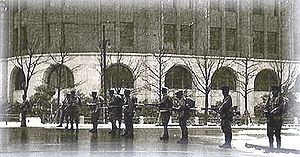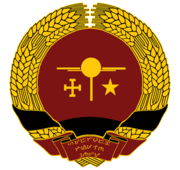Great Rectification
This article is incomplete because it is pending further input from participants, or it is a work-in-progress by one author. Please comment on this article's talk page to share your input, comments and questions. Note: To contribute to this article, you may need to seek help from the author(s) of this page. |
 Workers being herded out of their workplaces for "union inspection" | |
| Native name | |
|---|---|
| Date | March 21, 1954 – February 20, 1960 |
| Duration | 6 years |
| Location | Janpian Union of Revolutionary States |
| Also known as | The Great Correction, The Reign of Spider Lillies, The Year of 54 |
| Cause | Political instability, political rivalry, lack of strong or legitimate authority, realization of the Party-State concept |
| Motive | Political Repression, Consolidation of authority, fear of counter-revolutionaries, fear of foreign invasion or 5th columnists |
| Target | Perceived Counter-Revolutionaries, Rival Lorists, Dissidents, Revolutionary Council Members, Political Rivals, Party Members, Activists, Union Councilors |
| Deaths | Official Estimate:
|
The Great Rectification, also known as the Reign of Spider Lilies, was an early period in Janpian Union's history, following the victory of the All-Labor Union Party over Janpia and the subsequent establishment of the Janpian Union of Government Workers' Party. During this period, a series of mass arrests, executions, repressions, violence, and political turmoil plagued the young Party-State, mainly owing to strong revolutionary fervor, fears for a counter-revolutionary plot, and the lack of strong authority over the newly established Party, provided the near-anarchic political landscape that came as an aftermath of the Janpian Civil War. The term Great Rectification was coined by Marshal Hatuscho Garinov, who, in 1960, described it as an era of cleansing the Party from any disunifying elements and strengthening it under discipline and hard work. For this reason is how it also became the Party's current motto.
The origin of the Great Rectification stems from different reasons. During the Janpian Civil War, the All-Labor Union Party, which is comprised of multiple pro-workers and lorist parties as well as collaborationist parties and groups, has united under the Union Pact, which temporarily halted any ideological disputes, and uniting them under the principle to thwart off their common enemies such as the pro-monarchists, republicans, and non-labor groups. Despite the Union Pact being the founding principle of the All-Labor Union Party, these disputes and conflicts would once again surface under the functionaries of the subsequently established successor which is the Janpian Union of Government Workers' Party. Another reason is that due to the ideal for a stateless society, many party members calls for the complete disbandment of the successor Party, and to allow the reign of no reigns for the 5th era. While this is rectified by the Party-State concept, in which the de-jure there is no state in Janpia but the Party, many radical members still believed that the Party is a quasi-state, with its name even having a term "Government" within it. Some Party members such as Hatuscho have rebutted that the term was used as it only means authority, in which by no means it is a state. Among other reasons for the Great Rectification also includes (TBA)
Timeline
Wider Rectification
The Great Rectification was performed by any members of the Party and it often lacked any due process. Two disagreeing members of the Party often call each other out as counter-revolutionary based on simple or exaggerated technicalities, which often leads to arrest, or execution without prior review. Due to its revolutionary nature and its equal ideals, even the highest positions of the Party is not safe from the rectification, with the Office of the People's Marshal being often vacant or subject to extreme and often deadly rivalries.


